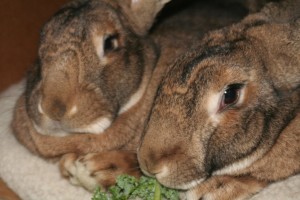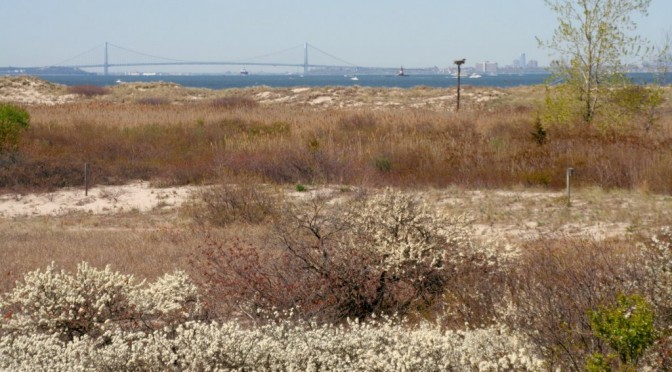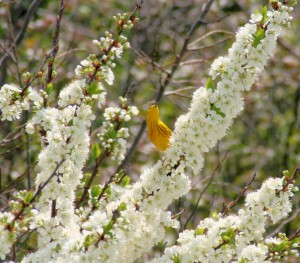Another of the rose kin
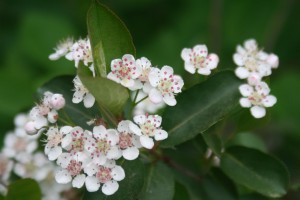 The black chokeberries (Aronia melanocarpa) are blooming beside the pond this week; the red variety is said to be attractive to birds, but the black certainly is not. Last year’s dried up berries remain on the plant, uneaten. The small, pinkish-white flowers have the characteristic 5 petals of the rose family.
The black chokeberries (Aronia melanocarpa) are blooming beside the pond this week; the red variety is said to be attractive to birds, but the black certainly is not. Last year’s dried up berries remain on the plant, uneaten. The small, pinkish-white flowers have the characteristic 5 petals of the rose family.
Please share carrot recipes!
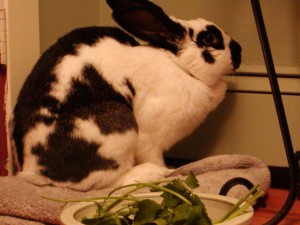 So. I brought Dora home from the vet this evening. She started eating some on her own and making pooties. The vet felt it was safe to let her continue to recover at home. His instructions were to give pain meds and gut motility drugs every 12 hours, encourage her to eat, and syringe feed her as necessary. Giving her meds is not easy and syringe feeding her is impossible – she stresses out too much. I have to sit on her and hold her down to get the meds in her. I’m spoiled by my other bunny who comes running for her twice daily meds, I think. I’ve forgotten how difficult this can be with a rabbit. I’ve put a smorgasbord of favorites in front of her, but all she will eat is carrot tops. Not much of the carrot itself, just the tops. She’s turning her nose up at her old favorite – apples. She’ll nibble politely at red cabbage. Romaine, green-leaf lettuce, endive, dandelions, kale, parsley, cilantro, dill, arugula – no go. Just carrot tops. So. I bought 5 bunches of organic carrots to get us through ’til the morning and am overloaded with carrots. I have a friend who makes a scrumptious carrot cake, I can add a few to chicken soup with matzo balls. What will I do with all these carrots?
So. I brought Dora home from the vet this evening. She started eating some on her own and making pooties. The vet felt it was safe to let her continue to recover at home. His instructions were to give pain meds and gut motility drugs every 12 hours, encourage her to eat, and syringe feed her as necessary. Giving her meds is not easy and syringe feeding her is impossible – she stresses out too much. I have to sit on her and hold her down to get the meds in her. I’m spoiled by my other bunny who comes running for her twice daily meds, I think. I’ve forgotten how difficult this can be with a rabbit. I’ve put a smorgasbord of favorites in front of her, but all she will eat is carrot tops. Not much of the carrot itself, just the tops. She’s turning her nose up at her old favorite – apples. She’ll nibble politely at red cabbage. Romaine, green-leaf lettuce, endive, dandelions, kale, parsley, cilantro, dill, arugula – no go. Just carrot tops. So. I bought 5 bunches of organic carrots to get us through ’til the morning and am overloaded with carrots. I have a friend who makes a scrumptious carrot cake, I can add a few to chicken soup with matzo balls. What will I do with all these carrots?
More views from Sandy Hook
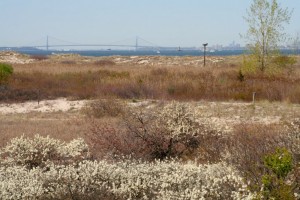 I just can’t seem to get enough beach plum pics – the dunes at North Pond are covered with it. Poison ivy grows like mad out there too and is just starting to green up some in this view from below the hawk watch platform. In the near distance is an occupied osprey platform and behind that is the Verranzano Bridge which connects Brooklyn and the rest of NYC to Staten Island.
I just can’t seem to get enough beach plum pics – the dunes at North Pond are covered with it. Poison ivy grows like mad out there too and is just starting to green up some in this view from below the hawk watch platform. In the near distance is an occupied osprey platform and behind that is the Verranzano Bridge which connects Brooklyn and the rest of NYC to Staten Island.
Today was my volunteer day at the Sandy Hook Bird Observatory; lots of people around, but few birds from what I heard. Quite a few of the visitors today were new birders who I love to talk with – their enthusiasm is great and spring migration is a perfect time to pick up binoculars for the first time.
Somehow I forgot to bring my camera with me today, so I missed the chance to photograph the white-crowned sparrows and the hummingbirds that are coming to the center’s feeders. Chipping sparrows have been moving through my yard, but I haven’t seen a white-crowned yet. I’ve also had my hummingbird feeder out for a few weeks at home, but haven’t had any, yet. For some reason, I can’t seem to attract them until mid-July.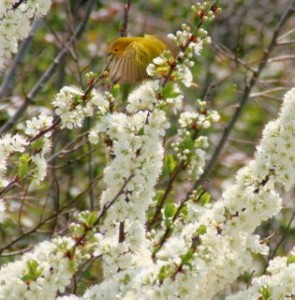
Here’s another shot of the Yellow Warbler from Friday. I heard one of these singing this afternoon, but he was hidden in the foliage of a hackberry tree.
Dora update (with bad pictures)
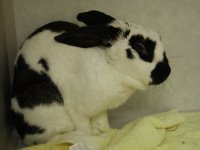 Dora is still at the vet’s and will be for a few more days. So long as she continues to improve, I hope to bring her home on Monday evening. My vet recommended surgery on Thursday because she hadn’t shown any improvement overnight and wasn’t responding to medicine. With other bunnies that have had bouts with GI Stasis, I’ve always been very conservative and waited it out. I was terrified of the surgery. Somehow with Dora I was brave enough to take my vet’s advice and allowed him to perform the surgery, called a gastrotomy.
Dora is still at the vet’s and will be for a few more days. So long as she continues to improve, I hope to bring her home on Monday evening. My vet recommended surgery on Thursday because she hadn’t shown any improvement overnight and wasn’t responding to medicine. With other bunnies that have had bouts with GI Stasis, I’ve always been very conservative and waited it out. I was terrified of the surgery. Somehow with Dora I was brave enough to take my vet’s advice and allowed him to perform the surgery, called a gastrotomy.
If you happened to read the link in my last Dora post, you might remember that this surgery is considered by many vets to be a last resort. My vet doesn’t agree with that, and feels it should be done sooner, rather than waiting until the bunny is at death’s doorway. So, he opened up her stomach to remove the mass of food and hair and fiber that she couldn’t pass on her own. As it was, her stomach was bloated to twice its normal size and was putting pressure on her other organs. That’s why she wasn’t eating or pooping and was so painful.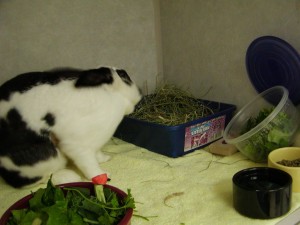
You wouldn’t know it from these pics, but Dora is improved today. She was doing normal bunny thiings like washing her face (in the photo above left) and scratching her ears (at right). She ate a little bit of salad and pooped some for the first time since Tuesday. She still needs to be syringe-fed and is getting fluids and pain meds (you should see the size of her incision!), but the docs thinks she is on the mend. Good news!
Yellow Warbler
Michelle’s waterbabies!
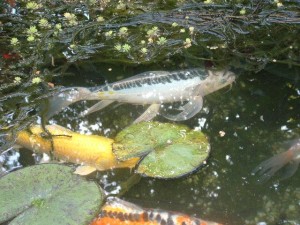
Michelle is a fellow bunny-lover (remember pics of her French Lop, Tink?) and we’ve been chatting about our fish ponds lately. She lives down south so her pond plants are way ahead of anything happening around my pond. I’ve been wanting to post some current pics, but it looks so barren out there, still. The perennials on the pond’s edge are up and growing, but other than a few volunteer water lilies (yay!) there is nothing but algae. Well, no more algae, actually. We turned on the filter and uv light last weekend, just before we got to the *pea soup* stage after the complete water change we did a few weeks ago. My tiny little goldfish look so lonely and vulnerable out there!
Michelle’s koi look very robust, don’t they? And look at the size of those lily pads! I’m jealous. The plants she calls weeds are Parrot’s Feather and provide cover and spawning surfaces for fish. Parrot’s Feather is tender, so I have to buy it new every year, whereas Michelle thinks she is overrun with it because it doesn’t die back in her warmer climate. I have that problem with mint around my pond; it finds its way into every nook between the rocks and grows with abandon. I yank it out by the handful, which only seems to make it even more vigorous.
Michelle says that she has one koi that she can pet! My little guys are not quite that friendly, but they do like to swim around my legs and nibble on my toes when I’m in the pond cutting back the plants. Mostly I think they’re interested in whatever I stir up along the bottom as I wade through the water. Silly fish.
Thanks, Michelle, for your email and sharing a pic of your waterbabies! I needed the distraction from my bunny-worrying. You’re the best!
5/3/06 Mid-week bunny fix (sort of)
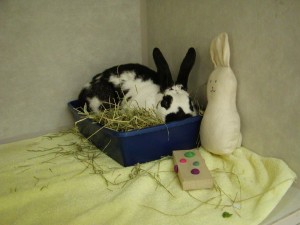 Dora is at the vet’s tonight.
Dora is at the vet’s tonight.
🙁
I took the afternoon off from work and brought her in to the vet because she’s been acting *off* the last day or two and not eating like she should and not pooping. Bad news for a bunny.
The photo at left is her in her hospital cage zonked out on pain meds. I visited her tonight after my final meeting with students and brought a special salad with her favorite veggies and her toys. All of which she ignored. I hate to leave a bunny in the hospital, especially one as sensitive as my Dora, because being away from home causes its own problems. So a bunny who was not eating well is now not eating at all because she is timid and fearful in an unfamiliar place and is zonked out on pain meds. Pain medication is important for a rabbit who is ill, so I should be glad that my vet is willing to give it, because many vets do not routinely give pain meds to rabbits. Even after spay/neuter procedures – can you imagine? I have to convince myself that the she needs to be there, even if it means that she will get worse before she can get better.
She is being treated for GI Stasis and needs subQ fluids and injectable meds. I’ve done those things at home with other bunnies, but not with a bunny quite like Dora. She’s only been with me for 6 months or so and will not be handled. I can pet her and kiss her and play with her, but heaven forbid I even think about picking her up and she bolts. No way can I hold her down to give her shots, or hold her still for subQ fluids. So I left her there tonight, hoping that the meds will do their work and get her digestive system working properly, so that I can bring her home with me.
Singing lessons (for Linda)
 My ears are much better than my eyes at identifying birds. My distance vision is not good and I’m too vain to wear my eyeglasses other than when I’m driving. I find glasses especially uncomfortable with binoculars. Because I have trouble spotting the movement of birds, I’ve come to rely on my ears more than my eyes and have tried over the years to develop my knowledge of bird songs. It’s a handy skill to have (and a good way to impress non-birding friends) and is easy to do if you’re an auditory person like me. I’ve always learned best by listening and in school was often reprimanded for *daydreaming*, when in fact I was paying close attention with my ears rather than my eyes.
My ears are much better than my eyes at identifying birds. My distance vision is not good and I’m too vain to wear my eyeglasses other than when I’m driving. I find glasses especially uncomfortable with binoculars. Because I have trouble spotting the movement of birds, I’ve come to rely on my ears more than my eyes and have tried over the years to develop my knowledge of bird songs. It’s a handy skill to have (and a good way to impress non-birding friends) and is easy to do if you’re an auditory person like me. I’ve always learned best by listening and in school was often reprimanded for *daydreaming*, when in fact I was paying close attention with my ears rather than my eyes.
In the sprin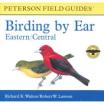 g I like to *warm-up* my ears to warbler song by listening to birdsong cd’s. This way I avoid the frustration of hearing birds that I can’t see while still knowing who’s out there singing. I like to play the cd’s at bedtime and usually fall asleep to their sweet seranade. I also make a *cheat sheet* that I carry with me when birding to help me distinguish between certain birds that I have trouble with. My favorites are the “Peterson’s Birding by Ear” and “Peterson’s More Birding by Ear”.
g I like to *warm-up* my ears to warbler song by listening to birdsong cd’s. This way I avoid the frustration of hearing birds that I can’t see while still knowing who’s out there singing. I like to play the cd’s at bedtime and usually fall asleep to their sweet seranade. I also make a *cheat sheet* that I carry with me when birding to help me distinguish between certain birds that I have trouble with. My favorites are the “Peterson’s Birding by Ear” and “Peterson’s More Birding by Ear”.
My friend Linda at work wants to learn about birds and I’ve offered to bring her along on a spring walk. She’s dissuaded by the early hour and suggests we have brunch, then bird, and finish up with some shopping. We have a running joke where she *sings* a bird song that she heard that morning to me and I’m supposed to tell her what it is that she heard. Somehow all of her *songs* sound the same. This morning she saw a cardinal and I tried to teach her its song as “Tear-tear-tear.” With her Brooklyn accent it turned into something unrecognizable, but we’ll keep working on it.
A LISTENER’S GUIDE TO THE BIRDS by E.B. White
Wouldst thou know the lark?
Then hark!
Each natural bird
Must be seen and heard.
The lark’s “Tee-ee” is a tinkling entreaty.
But it’s not always “Tee-ee” –
Sometimes it’s “Tee-titi.”
So watch yourself.
Birds have their love-and-mating song,
Their warning cry, their hating song;
Some have a night song, some a day song,
A lilt, a tilt, a come-what-may song;
Birds have their careless bough and teeter song
And, of course, their Roger Tory Peter song.
The studious ovenbird (pale pinkish legs)
Calls, “Teacher, teacher, teacher!”
The chestnut-sided warbler begs
To see Miss Beecher.
“I wish to see Miss Beecher.”
(Sometimes interpreted as “Please please please ta
meetcha.”)
The redwing (frequents swamps and marshes)
Gurgles, “Konk-la-ree,”
Eliciting from the wood duck
The exclamation “Jeeee!”
(But that’s the male wood duck, remember.
If it’s his wife you seek,
Wait till you hear a distressed “Whoo-eek!”)
Nothing is simpler than telling a barn owl from a veery:
One says, “Kschh!” in a voice that is eerie,
The other says, “Vee-ur” in a manner that is breezy.
(I told you it was easy.)
On the other hand, distinguishing between the veery
And the olive-backed thrush
Is another matter. It couldn’t be worse.
The thrush’s song is similar to the veery’s,
Only it’s in reverse.
Let us suppose you hear a bird say, “Fitz-bew,”
The things you can be sure of are two:
First, the bird is an alder flycatcher (Empidonax traillii
traillii);
Second, you are standing in Ohio – or as some people
call it, O-hee-o-
Because, although it may come as a surprise to you,
The alder flycatcher, in New York or New England,
does not say, “Fitz-bew,”
It says, “Wee-be-o.”
“Chu-chu-chu” is the note of the harrier,
Copied of course, from our common carrier.
The osprey, thanks to a lucky fluke,
Avoids “Chu-chu” and cries, “Chewk, chewk!”
So there’s no difficulty there.
The chickadee likes to pronounce his name;
It’s extremely helpful and adds to his fame.
But in spring you can get the heebie-jeebies
Untangling chickadees from phoebes.
The chickadee, when he’s all afire,
Whistles, “Fee-bee,” to express his desire.
He should be arrested and thrown in jail
For impersonating another male.
(There’s a way you can tell which bird is which,
But just the same, it’s a nasty switch.)
Our gay deceiver may fancy-free be
But he never does fool a female phoebe.
Oh, sweet the random sounds of birds!
The old-squaw, practising his thirds;
The distant bittern, driving stakes,
The lonely loon on haunted lakes;
The white-throat’s pure and tenuous thread-
They go to my heart, they go to my head.
How hard it is to find the words
With which to sing the praise of birds!
Yet birds, when they get singing praises,
Don’t lack for words – they know some daisies:
“Fitz-bew,”
“Konk-la-reeee,”
“Hip-three-cheers,”
“Onk-a-lik, ow-owdle-ow,”
“Cheedle, cheedle chew,”
And dozens of other inspired phrases.
Got that, Linda?
😉
Books for plant geeks
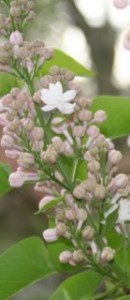 When I was a newly-minted master gardener I went out and bought two great reference books so that I would sound smart when answering questions on the helpline or during community events where we volunteer. My dear friend Debbie likes to tease me that I am never able to answer any of her gardening questions. She says that my answer is always the same, “but I don’t grow that.” Which is true; she and I have very different tastes in plant material.
When I was a newly-minted master gardener I went out and bought two great reference books so that I would sound smart when answering questions on the helpline or during community events where we volunteer. My dear friend Debbie likes to tease me that I am never able to answer any of her gardening questions. She says that my answer is always the same, “but I don’t grow that.” Which is true; she and I have very different tastes in plant material.
I guess she thinks that I ought to know everything there is to know about plants. Th e fact is, most master gardeners are just people who have an interest in gardening and are willing to volunteer their time. We’re trained in certain aspects of horticulture, but we’re not expected to know everything. Most of us have a particular interest or area of expertise, but the rest of the time our answers come from books. Knowing where to find answers is important.
e fact is, most master gardeners are just people who have an interest in gardening and are willing to volunteer their time. We’re trained in certain aspects of horticulture, but we’re not expected to know everything. Most of us have a particular interest or area of expertise, but the rest of the time our answers come from books. Knowing where to find answers is important.
Two books I use often are “Dirr’s Hardy Trees and Shrubs” and its companion “Manual of Woody Landscape Plants”. Michael Dirr has many excellent horticulture titl es, but these are the most popular. The first contains lovely glossy photos and minimal information on care; the second volume is much more detailed (and intimidating) and includes info on propagation, culture, pests and diseases, and landscape value. It also includes Dirr’s personal comments and growing experiences with each species covered. His comments and growing tips are the most enjoyable part, in my opinion.
es, but these are the most popular. The first contains lovely glossy photos and minimal information on care; the second volume is much more detailed (and intimidating) and includes info on propagation, culture, pests and diseases, and landscape value. It also includes Dirr’s personal comments and growing experiences with each species covered. His comments and growing tips are the most enjoyable part, in my opinion.
